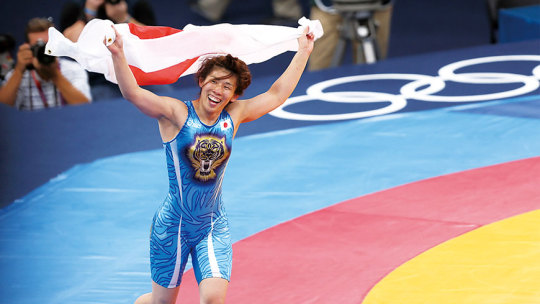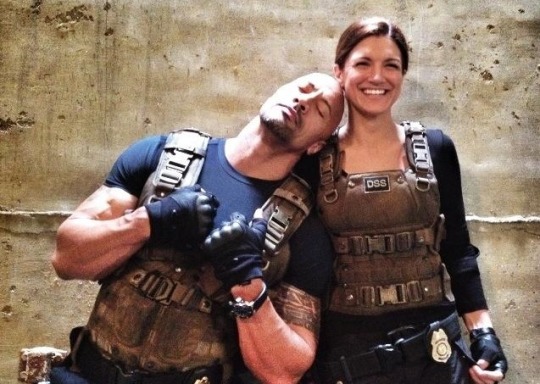It seems a popular trend in trying to defend terrible costume designs with random pictures of female wrestlers or MMA fighters. Usually accompanied by some sort of rant about how anyone who questions the perfection of these costumes is the sexist one!
Yes, there are many sexualized costumes in women’s sports. It’s not because the costumes are flawless. Rather it is a sign that female athletes often suffer under the tyranny of Creepy Marketing Guy too.
At the end of the day, justifying sexist double standards in the media by pointing to more sexist double standards in the media only showcases how wide spread the problem is.
More under the cut.
– wincenworks
Showmanship vs Sportsmanship
It’s a public secret that WWE isn’t exactly about competing to see who has the greatest combat skills. WWE and those like it are about over the top stunts, fast paced drama and general entertainment.
If we accept that climbing up on a giant prop so that you can taunt your opponent, call for the crowd to cheer and then drop down with a body slam is not serious fighting behaviour, we should be able to accept they are not wearing serious costumes either.
For reference, compare any rebuttal outfit to what Saori Yoshida wore when she took Gold at the 2012 Olympics.

Rules of Engagement
Unsurprisingly in heavily regulated sports that have to adhere to regulations from sponsors, insurance and law enforcement – they have a lot of rules about what you can and can’t do to each other.
Even in more liberal fighting sports such as MMA or Ultimate Fighting, the opponents are not actually trying to kill or permanently injure each other – they’re trying to force a submission through allowed techniques. Certainly you can’t bring claw weapons, throw fireballs, use grappling hooks or rip their head off at the end of the round.
Weight Classes
This is usually more an objection when we talk about body types or lack of muscle, but there’s always no shortage of people rushing to post images of conventionally attractive young women who are professional fighters – thus insisting that all warrior women should conform to these standards.
This overlooks a rather critical aspect of the above rules of engagement – that in order to keep competitions within the many rules fair, fighters are sorted into weight classes. Professional fighters need superb discipline and go to great lengths to balance performance vs weight – because they need to in order to be allowed to fight in their weight class.
Unsurprisingly, height is also and advantage so in many of lighter weight classes the contestants tend to be of slim build and a few invariably fall within the conventional beauty standards.
Sponsorship
The lighter weight classes are particularly important, because for any combat sport event to get big tournaments with professional fighters, promotions, photo shoots, etc they need sponsors. The bigger the sponsors, the bigger the events. WWE’s sponsors include Disney and Mattel. And this is where the tyranny of Creepy Marketing Guy comes in.
Companies sponsor events and fighters in order to boost their image and promote themselves. That means the marketing department gets involved and so does the flawed mentality that sex sells – this effects both the events and the individual fighters.
Now before we continue – I need to stress here that the problem is not the women who benefit from these opportunities and/or enjoy these aspects of the sport. The problem is that the circumstances create additional barriers for women who do not fit or feel comfortable within the constraints.
Journalists and brodudes alike constantly try to justify this focusing on sound bytes or photos of successful female athletes who seem to be okay with it – that’s not fair to the women who dropped out because of these issues or the women who succeed.
The upper limit for the absolute heaviest weight class for women that receives sponsorship for national and international events is 66 kgs or 145 lbs. For men, it’s 120kgs or 265 lbs AND occasionally they experiment with super heavyweight – a division with no upper weight limit at all.
To put this in perspective: Fighter/actress Gina Carano was a champion fighter in the heaviest divisions of Mixed Martial Arts. She tended to weight 140 – 143 pounds during her fight career and once had to publicly strip naked to make her weigh in. This is her with regular sized, just plain actor, Ewan McGregor in Haywire:

This is her generously allowing The Rock to lean on her while he takes a nap:

On top of that, if you want to be a professional fighter you’re going to need a very rigorous training schedule, be able to travel, take time off to heal up after fights, etc. So it’s in your best interests to attract sponsors who will pay you to do all of that.
The downside is, marketing guys will tend to want you to pose for their promotions and fight wearing items of clothing that they pick for you to wear during promo shoots. It also means that marketing guys additional funding options such as interviews, cover shoots, etc tend to want to focus more on “isn’t she sexy!?” rather than “isn’t she a badass!?”
This isn’t just a problem in fighting sports
Back in 2012, weight lifter Sarah Robles lived poverty nearly missed out on going to Olympics because she had no corporate sponsors. Beach Volleyball is regularly controversial because of it’s double standard where women wear bikinis and the men wear shorts and shirts.
There’s a definite trend that if the female athletes for a sport don’t look conventionally sexy while competing it will struggle for coverage and sponsors. The Australian Women’s Olympic Basketball team, who won Silver in 2000, 2004 and 2008, got less sponsorship in 2012 than the Australian Men’s Olympic Basketball Team who have never brought back a medal.
So long as society remains comfortable with this idea that women aren’t worth giving attention to unless they’re sexy, there’s never going to be any shortage of examples like this. That doesn’t make any one example okay.
– wincenworks







